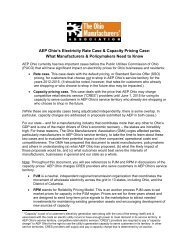2012 Ohio Election Guide - Gripelements.com
2012 Ohio Election Guide - Gripelements.com
2012 Ohio Election Guide - Gripelements.com
You also want an ePaper? Increase the reach of your titles
YUMPU automatically turns print PDFs into web optimized ePapers that Google loves.
economic trends METHODOLOGYMethodology Used to Produce Economic TrendsFor U.S. Congressional, <strong>Ohio</strong> Senate, and <strong>Ohio</strong> House DistrictsJune 1, <strong>2012</strong>(displayed on pages 192–197)The economic trends were produced using the Quarterly Census of Employment and Wages(QCEW). The QCEW database is derived from <strong>com</strong>pany level data obtained for unemployment<strong>com</strong>pensation tax collection purposes. The Center for Economic Development in the UrbanCenter of the Maxine Goodman Levin College of Urban Affairs at Cleveland State Universitymaintains, manages, and edits a longitudinal QCEW database. The QCEW data contain <strong>com</strong>panies’address, county, industry classification, total employment, and total payroll for most <strong>com</strong>panieswith paid employees (by site location) in <strong>Ohio</strong>. The QCEW data has confidentiality restrictions thatprotect <strong>com</strong>panies’ information.The employment, number of establishments, and payroll totals for each district were producedfrom aggregated QCEW data. Addresses were geocoded and assigned census blocks wherepossible and blocks were assigned to districts. For the <strong>com</strong>panies for which addresses could notbe geocoded, counties, municipalities and zip codes were used to assign them to districts.The assignment process for districts was the following:1. Most <strong>com</strong>panies in the QCEW database were assigned a census block based on their address.These records were then assigned a district based on the census blocks in the district.2. For the records without a census block, the county was used to assign a district. If thecounty is <strong>com</strong>pletely within a district, the district was assigned based on the county. Thereare 49 counties <strong>com</strong>pletely within house districts, 69 counties are <strong>com</strong>pletely within senatedistricts, and 65 counties are <strong>com</strong>pletely within congressional districts.3. For those addresses not assigned by the previous methods, the <strong>com</strong>bination of counties,municipalities and zip codes were used to assign the district. If a county, city, and zip code<strong>com</strong>bination fell totally within one district, those records were assigned that district.In several cases, the totals in a senate district differ from the sum of its three housedistricts, since more counties are <strong>com</strong>pletely within a senate district than within a housedistrict — 69 counties versus 49. In these cases, all the data can be assigned to a senate or housedistrict based on the county alone and it is not necessary to use the other address <strong>com</strong>ponents.Less than 3% of employment in any year is not assigned a district. This occurs when anemployee worked in more than one county and, therefore, was not assigned to any single countyand county was used to assign a district. Also, a limited number of records had no or invalid dataon addresses, municipalities, counties, and zip codes and thus were not assigned to a district.<strong>2012</strong> OHIO ELECTION GUIDE — 191





